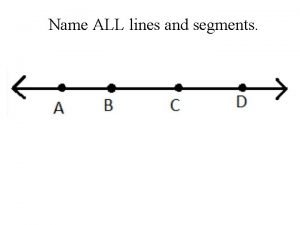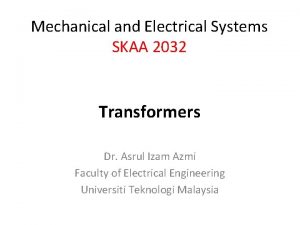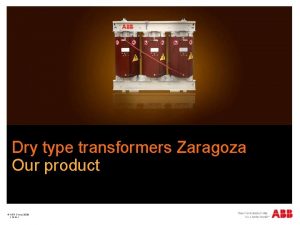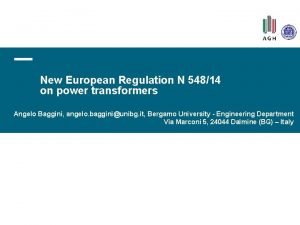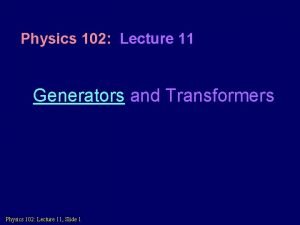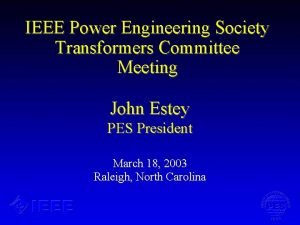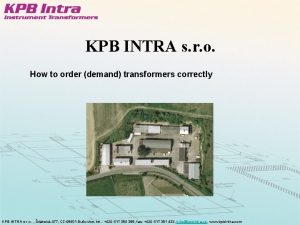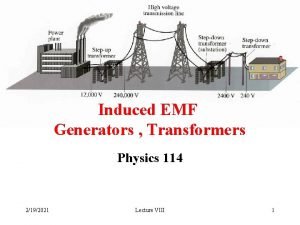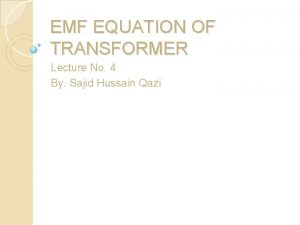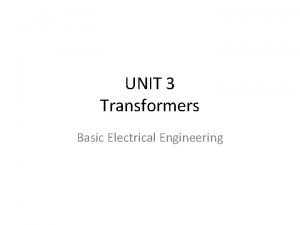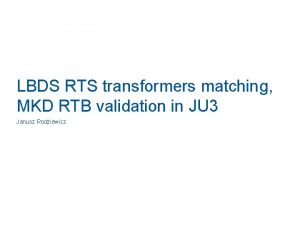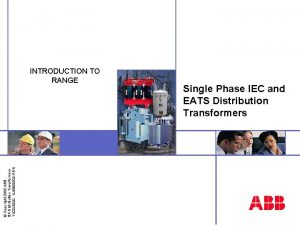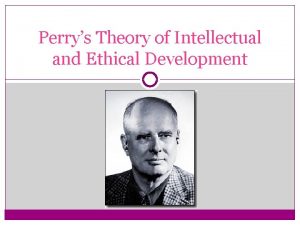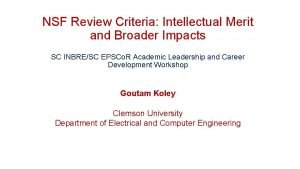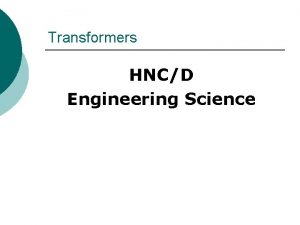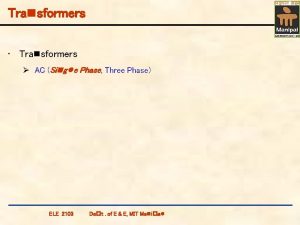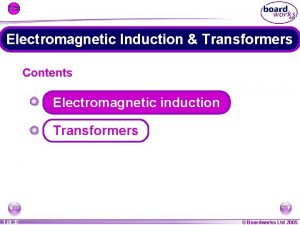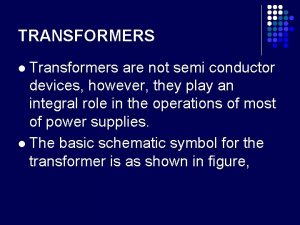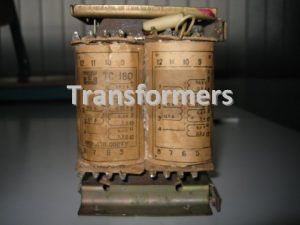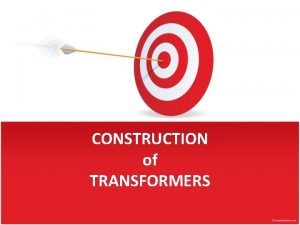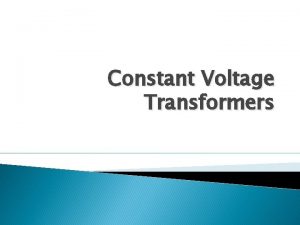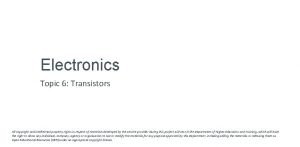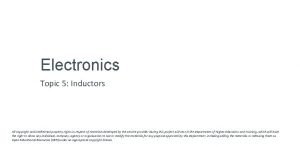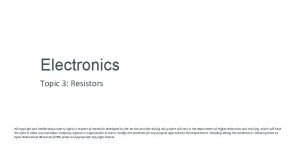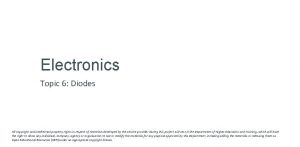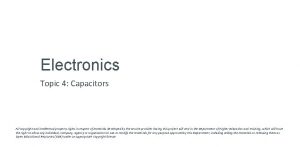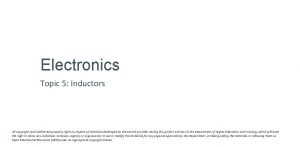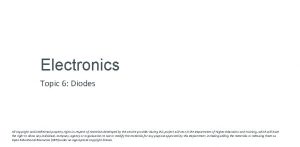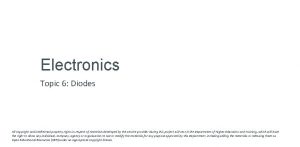Transformers Topic 1 Transformers All copyright and intellectual


































- Slides: 34

Transformers Topic 1: Transformers All copyright and intellectual property rights in respect of materials developed by the service provider during this project will vest in the Department of Higher Education and Training, which will have the right to allow any individual, company, agency or organisation to use or modify the materials for any purpose approved by this Department, including selling the materials or releasing them as Open Educational Resources (OER) under an appropriate copyright license.

Assumed prior learning 05_01_00 05_01_02 05_02_01

Outcomes By the end of this unit you will be able to: Describe how transformers work; Explain why transformers are so important; Use the transformer equation to calculate primary voltage, secondary voltage, the number of primary coils and the number of secondary coils;

Unit 1. 2: What are Transformers

Introduction Transformers come in many sizes. Some fit into your cell phone charger. Others take up whole rooms. All transformers, however, are voltage (and hence current) changing machines. They are used to increase or decrease the voltage. But how do they do this and why is this even important? Let’s find out.

The journey of electricity You may not think about it, but the electricity powering whatever device you are reading this on, probably had to travel hundreds of kilometres to get to it. Click on each part of the image to find out how this happens.

Power stations Almost all the electricity used in the world is made in a power station far from where it is needed. Power stations in South Africa generate electricity at about 11, 000 V or 11 k. V. This is a dangerously high voltage but still too low for electricity to be sent the hundreds of kilometres to where it is needed.

Transformer •

National transmission lines By making the voltage very high, the current that needs to flow through the transmission lines is relatively small. This means that far thinner (and cheaper) cables can be used to carry the same amount of power. A smaller current also means less electrical energy is lost due to the resistance of the cables. Lastly, very high voltages give the electricity the force it needs to travel long distances. Win!

Substation 132 k. V is fine travelling along high cables through the countryside. It is too dangerous for cables that run inside cities. So substations use distribution transformers to reduce or step-down the voltage to about 11 k. V again and distribute the electrical energy from a few transmission lines to many more distribution lines. Because the transmission current gets split between lots of distribution wires, each wire only needs to carry a portion of the overall current, so reducing the voltage does not mean we have to increase the cable thickness.

Houses, shops and other buildings From the substation, the voltage gets stepped down once or twice more until it gets to 220 V and is delivered to your house or 380 V for many workplaces. At each step, the current is split between more and more cables going to more and more places. Voltages like 11 k. V delivered to your house would mean that sparks would fly out of your plug! Stepping down the voltage to 220 V stops this from happening. Your cellphone charger also has a transformer that steps this voltage down again to about 3 V - 5 V – just right for your phone.

Essential transformers We can now see that transformers allow us to transform (increase or decrease) the voltage and that, without them, the whole modern world would not be possible. Watch the video for a great introduction to how transformers work YT 01

Transformer action In summary so far, transformers 1 Have a primary and secondary coil The coils are physically unconnected but 2 magnetically coupled The magnetic field of the primary coil induces a 3 voltage and current in the secondary coil by electromagnetic induction The subsequent transfer of energy from the primary 4 to secondary coil is called transformer action

Its all in the turns The secret of how transformers work is all in the number of turns of wire in their primary and secondary coils. Vid 01 Watch the video to find out why.

The transformer equation It is the ratio of turns in the primary and secondary coils which determines how the voltage gets transformed. Click on each part of the equation to learn more.

The transformer equation Let’s put this equation to use. A transformer has 100 turns in the primary coil and 20 turns in the secondary coil. A voltage of 240 V is applied across the primary coil. What voltage is produced across the secondary coil? Try this question on your own first, then watch the worked solution video to see the answer. Worked solution

Your turn (pun intended!!) Try the next few questions using the transformer equation on your own.

Question 1 A transformer has 150 primary turns and 100 secondary turns. If the primary voltage is 12 V what will the secondary voltage be? a) b) c) d) 18 V 12 V 8 V 2 V

Question 2 A voltage of 450 V is measured across the secondary coil of a transformer. If the secondary coil has 750 turns and the primary coil has 1, 125 turns, what voltage is being applied across the primary coil? a) b) c) d) 675 V 300 V 450 V 850 V

Question 3 A voltage of 3, 500 V is applied across the primary coil and 23, 000 V is measured across the secondary coil of a transformer. If the primary coil has 780 turns, how many turns does the secondary coil have? a) b) c) d) Cannot be calculated 5126 119 780

Question 4 The primary coil of a transformer has 490 turns and the secondary coil 1065 turns. Will this transformer increase or decrease the voltage applied to the primary coil? a) Decrease b) Increase

Step-up and step-down You have probably noticed that the voltage on the secondary coil is not always less than the voltage on the primary coil. If the secondary coil has more turns, than this voltage will be higher. This is called a stepup transformer. Click on the step-up transformer.

A note on transformer current Transformers transfer power from the primary to the secondary coil. Ideally they do not create or consume power. If power = voltage x current, than if a transformer steps-down the voltage on the secondary coil, this means that the current in the secondary coil must be greater than the current in the primary coil to conserve power. OR

Step-up and step-down Click on the transformer where the current will be higher in the secondary coil than in the primary coil.

Conserving power No transformer is perfect. There is always some lose of energy. But most transformers are so efficient that we generally ignore any power losses. Watch the video to find out more. Vid 03

Another example A transformer has 600 turns on the primary coil connected to 220 V. The voltage and current on the secondary side is 16, 13 V and 5 A. What is a) The number of secondary turns; b) The primary current; c) The turns ratio; and d) The voltage per turn? Try the question on your own first, then watch the worked solution video. Worked solution

Power to you (pun intended…again!) Try the next few questions using the transformer and power equations on your own.

Question 1 blaa

A quick summary This image illustrates much of what we know about transformers so far. Click on the image so see a larger version.

Conclusion So far, we know that transformers change voltage. 2 sets of coils are magnetically coupled via 1 electromagnetic induction Transformer action transfers power from 2 the primary to the secondary coil The number of primary and secondary turns 3 determines how the voltage is transformed 4 The transformer equation: Click on the numbers to see each point

Video Briefing – Vid 01 Create a screencast video of an expert electrician explaining why the number of turns on the primary and secondary coil matter and how this leads to the transformer equation. Base the explanation on https: //www. youtube. com/watch? v=c 38 i. S 6 Voy. VU 1: 36 – 2: 48 1. 2. 3. 4. 5. 6. Coils are “connected” in series so sum of voltage in each turn is added to get the sum of the total voltage across the coil. Therefore, we can say that the voltage across primary coil is divided across each turn in the coil. This same voltage is then induced in each turn of the secondary coil. Assume we have 10 V across 10 turns in the primary. Each turn will have 1 V across it. Therefore, 1 V will be induced across each turn in the secondary coil. If there also 10 turns in the secondary coil, the total voltage across the coil will be 10 V. BUT if there are 5 turns, the voltage will be 5 V; AND if there are 15 turns the voltage will be 15 V We can write this mathematically like this: 1. For the primary coil - VP = NP x e. P (V=voltage across coil; N = number of turns; e=voltage across each turn) 2. For the secondary coil - VS = NS x e. S 3. But we know that e. P = e. S and e. P = VP/NP and e. S = VS/NS 4. Therefore VP/NP = VS/NS 5. But we can rearrange this equation to have all the turns on one side and all the voltages on the other 6. VP/VS = NP/NS or VS/VP = NS/NP 7. This is called the transformer equation and we use it to work out by how much a transformer changes the

Video Briefing – Vid 02

Video Briefing – Vid 03 Create a screencast video of an expert electrician explaining power conservation in a transformer and what this means for currents but using the following example and calculating x, y and z by assuming that power is conserved Primary 200 turns 400 V 7 A y. W Secondary 50 turns 100 V x. A z. W Power is conserved – Primary power = 400 V x 7 A = 2, 800 W. Therefore secondary power = 2800 W = 100 V x 28 A

Video Briefing – Vid 04
 Broad topic and narrow topic examples
Broad topic and narrow topic examples Narrowing down a topic exercises
Narrowing down a topic exercises Name three line segments
Name three line segments Copyright 2015 all rights reserved
Copyright 2015 all rights reserved Copyright 2015 all rights reserved
Copyright 2015 all rights reserved Dell all rights reserved copyright 2009
Dell all rights reserved copyright 2009 Copyright © 2018 all rights reserved
Copyright © 2018 all rights reserved Uses of transformer
Uses of transformer Functions of transformer
Functions of transformer Josipa mokrovića 12
Josipa mokrovića 12 Grounding transformers
Grounding transformers Abb dry type transformer
Abb dry type transformer Transformers
Transformers Roman transformers
Roman transformers Transformers
Transformers Transformers igor
Transformers igor Application of solid insulating material
Application of solid insulating material Transformers physics
Transformers physics Ieee transformers committee
Ieee transformers committee Transformers
Transformers Iec 60076 power transformers
Iec 60076 power transformers Kpb intra
Kpb intra Generator
Generator Emf equation of transformer
Emf equation of transformer Secondary terminal voltage of transformer
Secondary terminal voltage of transformer Rts transformer
Rts transformer Abb distribution transformers
Abb distribution transformers The intellectual and spiritual leaders
The intellectual and spiritual leaders Chapter 50 intellectual and developmental disabilities
Chapter 50 intellectual and developmental disabilities Health and social care intellectual development
Health and social care intellectual development Perry's theory of intellectual and ethical development
Perry's theory of intellectual and ethical development Father of italian renaissance
Father of italian renaissance Intellectual merit and broader impacts
Intellectual merit and broader impacts Which intellectual trait includes conscious understanding
Which intellectual trait includes conscious understanding Intellectual and moral education in huck finn
Intellectual and moral education in huck finn


